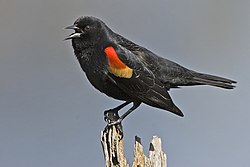Red-winged blackbird: Difference between revisions
No edit summary |
Atethnekos (talk | contribs) |
||
| Line 53: | Line 53: | ||
{{Commons|Agelaius phoeniceus}} |
{{Commons|Agelaius phoeniceus}} |
||
<gallery> |
<gallery> |
||
Image:Redwingedblackbird1.jpg|A male Red-winged blackbird in Southern Ontario. |
|||
Image:Blackbird-sunset-03.jpg|[[Backlighting (lighting design)|Backlit]] flock. |
Image:Blackbird-sunset-03.jpg|[[Backlighting (lighting design)|Backlit]] flock. |
||
Image:Black Bird, Red Winged.jpg|Red-Winged Blackbird in Central Park, NYC. |
Image:Black Bird, Red Winged.jpg|Red-Winged Blackbird in Central Park, NYC. |
||
Revision as of 05:33, 26 April 2008
| Red-winged Blackbird | |
|---|---|

| |
| Male | |
| Scientific classification | |
| Kingdom: | |
| Phylum: | |
| Class: | |
| Order: | |
| Family: | |
| Genus: | |
| Species: | A. phoeniceus
|
| Binomial name | |
| Agelaius phoeniceus (Linnaeus, 1766)
| |
The Red-winged Blackbird (Agelaius phoeniceus) is a passerine bird of the family Icteridae found in most of North and much of Central America. It breeds from Alaska and Newfoundland south to Florida, the Gulf of Mexico, Mexico and Guatemala, with isolated populations in western El Salvador, northwestern Honduras and northwestern Costa Rica. It may winter as far north as Pennsylvania and British Columbia, but northern populations are generally migratory, moving south to Mexico and the southern United States.
Description

The common name for this species is taken from the mainly black adult male's distinctive red shoulder patches, or "epaulets", which are visible when the bird is flying or displaying. At rest, the male also shows a pale yellow wingbar.
The female is blackish-brown and paler below. The female is considerably smaller than the male, at 17-18 cm (7 inches) length and 36 g weight, against his 22-24 cm (9.5 inches) and 64 g.
Young birds resemble the female, but are paler below and have buff feather fringes. Both sexes have a sharply pointed bill.
Diet
The Red-winged Blackbird feeds primarily on plant seeds, including weeds and waste grain, but about a quarter of its diet consists of insects, spiders, mollusks and other small animals, considerably more so during breeding season (Srygley & Kingsolver 1998). In season, it eats blueberries, blackberries, and other fruit. These birds can be lured to backyard bird feeders by bread and seed mixtures and suet.
Habitat
When migrating north, these birds travel in single-sex flocks, and the males usually arrive a few days before the females. Once they have reached the location where they plan to breed, the males stake out territories by singing. They defend their territory aggressively, both against other male Red-winged Blackbirds and against birds they perceive as threatening, including crows, Ospreys, hawks, and even humans. The Red-winged Blackbird inhabits grassy areas, and can be found in both wetland areas, such as freshwater and saltwater marshes, and dry upland areas, such as meadow, prairies, and old fields.
The call of this species is a throaty check, and the male's song is a scratchy oak-a-lee (see below), accompanied with a display of his red shoulder patches.
Reproduction
Red-winged Blackbirds are polygynous, with territorial males defending up to 10 females. However, females frequently copulate with males other than their social mate and often lay clutches of mixed paternity.
Pairs raise two or three clutches per season, in a new nest for each clutch. The nests are cups of vegetation, and are either built in shrubs or attached to marsh grass. A clutch comprises three to five eggs. These are incubated by the female and hatch in 11-12 days. Red-winged Blackbirds are hatched blind and naked, but are ready to leave the nest ten days after hatching.
Predation of eggs and nestlings is common. Some nest predators include other birds, snakes, and the raccoon.
Relationship with Humans
When the breeding season is over, Red-winged Blackbirds gather in huge flocks, sometimes numbering in the millions. In some parts of the United States, they are considered to be pests because these flocks can consume large amounts of cultivated grain or rice. This bird's numbers are declining due to habitat loss and the use of poison to prevent the loss of crops.
Subspecies
There are a number of subspecies, some of dubious status, but the 'Bicolored Blackbird' A. p. gubernator of California and central Mexico is distinctive. The male lacks the yellow wing patch of the nominate race, and the female is much darker than the female nominate. The taxonomy of this form is little understood, with the relationships between the two isolated Bicolored populations, and between these and Red-winged still unclear.
Despite the similar names, the Red-winged Blackbird is not related to the European Redwing or the Old World Common Blackbird, which are thrushes (Turdidae).
Gallery
-
A male Red-winged blackbird in Southern Ontario.
-
Backlit flock.
-
Red-Winged Blackbird in Central Park, NYC.
-
Red-Winged Blackbird picture from a book.
Media
References
- Template:IUCN2006 Database entry includes justification for why this species is of least concern
- Jaramillo, Alvaro & Burke, Peter (1999): New World Blackbirds. Christopher Helm, London. ISBN 0-7136-4333-1
- Srygley, Robert B. & Kingsolver, Joel G. (1998): Red-wing blackbird reproductive behaviour and the palatability, flight performance, and morphology of temperate pierid butterflies (Colias, Pieris, and Pontia). Biol. J. Linn. Soc. 64(1): 41–55. HTML fulltext
- Stiles, F. Gary & Skutch, Alexander Frank (1989): A guide to the birds of Costa Rica. Comistock, Ithaca. ISBN 0-8014-9600-4
External links
- Red-winged Blackbird videos on the Internet Bird Collection
- Red-winged Blackbird - Cornell Lab for Ornithology
- Red-winged Blackbird - USGS Patuxent
- Red-winged Blackbird - South Dakota Birds
- Red-winged Blackbird - eNature.com



